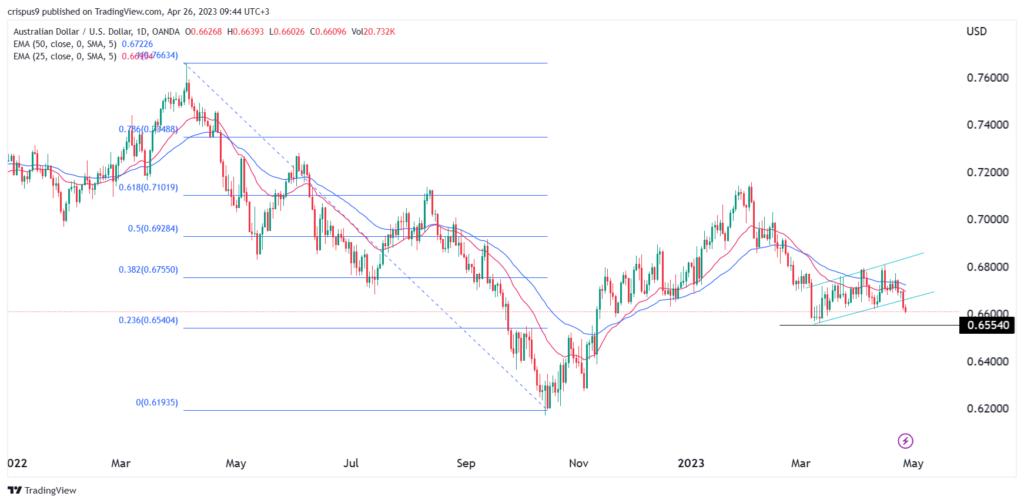[ad_1]
The AUD/USD exchange rate has made a bearish breakout in the past few days. It has dropped in the past two straight days as investors predict a divergence between the Federal Reserve and the Reserve Bank of Australia (RBA). It fell to a low of 0.6607, the lowest level since March 16 of this year.
Australia inflation data
The main AUD news was the latest Australian inflation data. According to the Australia Bureau of Statistics, the headline consumer price index dropped from 1.9% in Q4 to 1.4% in Q1. That decline was smaller than the median estimate of 1.3%. On a year-on-year basis, inflation dropped from 7.8% to 7.0% during the quarter. It remains significantly above the Reserve Bank of Australia (RBA) target of 2.0%.
The closely-watched trimmed and weighted mean CPIs declined at a bigger pace than expected. The trimmed mean CPi dropped from 6.9% to 6.6% in Q1 while the weighted mean remained unchanged at 5.8%. The two dropped to 1.2% on a QoQ basis.
These numbers came two weeks after the Reserve Bank of Australia delivered its interest rate decision. In it, the bank decided to leave interest rates unchanged for the first month in several meetings. Last week, minutes from the bank showed that the pause was needed for the officials to track the impact of the previous increases.
Therefore, there is a potential for the Fed and the RBA to diverge since analysts believe that Australia’s inflation and interest rates have peaked. In a note, an RBC analyst said:
“For an RBA that is reluctant to tighten much further and prepared to tolerate higher inflation to preserve the labour market gains, today’s data provide an excuse to stay on hold.”
The Fed is expected to deliver at least one more rate hike in the coming meeting in May. This will be divergent from what the RBA did and is expected to do in May.
AUD/USD technical analysis

The AUD/USD pair has made a bearish breakout in the past few days. It has managed to move below the lower side of the ascending channel shown in green. At the same time, the pair’s sell-off is being supported by the 25-day and 50-day moving averages and the 38.2% Fibonacci Retracement level.
The AUD to USD pair’s oscillators has continued drifting downwards. Therefore, the outlook of the pair is bearish, with the next key level to watch will be 0.6500.
Ad
Looking to capitalise on rising & falling USD, GBP, EUR rates? Trade forex in minutes with our top-rated broker, eToro.
10/10
81% of retail CFD accounts lose money
[ad_2]










 Join our Telegram Channel
Join our Telegram Channel